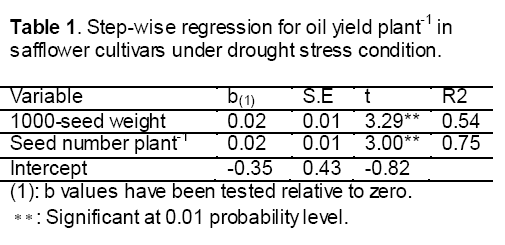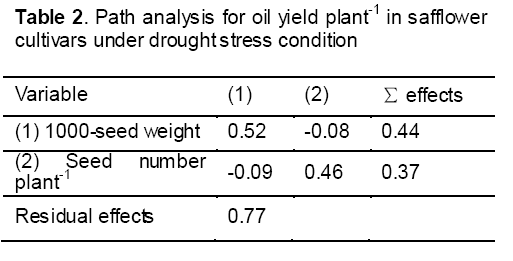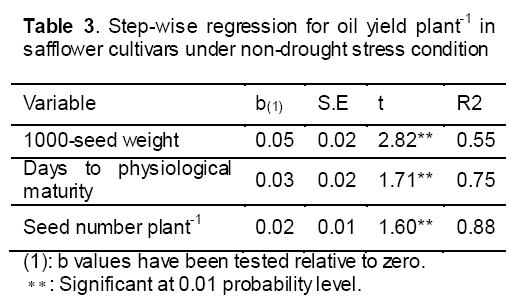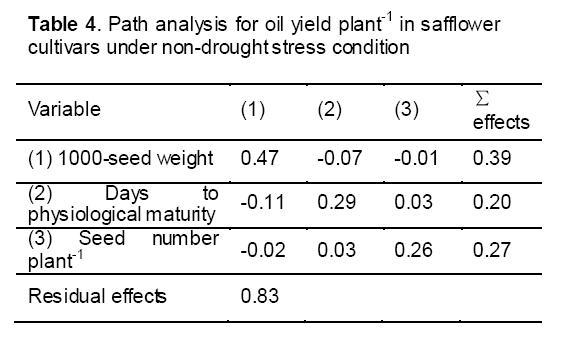Genetic Improvement of Oil Yield in Spring Safflower Cultivars under Drought and Non-drought Stress Conditions
Ahmad Reza Golparvar
Department of Agronomy and Plant Breeding,Khorasgan (Isfahan) Branch,Islamic Azad University,Isfahan,Iran
Abstract
Improvement of oil yield in safflower is very important in breeding of this crop. For this reason, ten spring safflower cultivars were sown at drought and non-drought stress conditions in a randomized complete block design with three replications. In drought condition, correlation analysis showed positive and significant relation of 1000-seed weight, seed number plant-1, seed yield plant-1 and seed oil percent with oil yield. Results of regression and path analysis revealed that traits 1000-seed weight and seed number plant-1 are the best selection criteria for genetic improvement of oil yield in drought stress condition. In non-drought condition, traits 1000-seed weight, days to physiological maturity and seed number plant-1 were the most important oil yield components and suggest for breeding of this trait. In conclusion, selection for higher amounts of 1000-seed weight and seed number plant-1 can improve indirectly oil yield in spring safflower cultivars under both drought and non-drought conditions
Keywords
Spring safflower,Selection criteria,Oil yield,Step-wise regression,Path analysis.
1. Introduction
Identification of the traits that affect seed and oil yield in safflower (Carthamus tinctorius L.) is very important in genetic improvement of these attributes. Especially,oil yield is a polygenic trait that direct selection per se isn’t effective for its. Therefore,indirect selection via traits having higher heritability and correlated strongly with oil yield has more genetic efficiency than direct selection in genetic improvement of this trait [1]. Correlation coefficient analyses help researchers to distinguish significant relationship between traits. Step-wise regression can reduce effect of non-important traits in regression model; in this way traits accounted for considerable variations of dependent variable are determined [2]. Path analyses that present by Li C C [3] have been extensively used in field crops. Path analysis is used to determine the amount of direct and indirect effects of the variables on the dependent variable [3,4].
Bratulin C [5] reported positive and significant relation between seed yield plant-1 and capitulum number plant-1 and 1000-seed weight in safflower genotypes. Cassato E et al [6] observed positive and significant correlation of capitulum number plant-1 with seed yield plant-1 in safflower. Paramaswarapa K G [7] identified that capitulum number plant-1 and thin seed pericarp are the best selection criteria for improvement of safflower oil yield. Kumar H et al [8] showed positive and significant relation between plant height,capitulum diameter and seed number capitulum-1 with seed and oil yield in safflower. Rao V et al [9] found high importance of capitulum number plant-1,capitulum weight and thin seed pericarp in breeding of seed and oil yield in safflower cultivars. Some researches on safflower genotypes revealed negative and significant correlation between oil yield with seed pericarp diameter [10,11].
Zheng N et al [12] and Arslan B [13] emphasized on indirect selection via higher capitulum number plant-1 and 1000-seed weight and lower number of branches along with thin seed pericarp for improvement of seed and oil yield in safflower. Ulukan H et al [14] reported positive and significant relationships between biological yield with plant height,pod number plant-1 and grain number pod-1 in faba bean genotypes. The total coefficient of determination was found as 63.6% in the regression model for biological yield as dependent variable. Direct effects of plant height,pod number plant-1 and grain number pod-1 upon biological yield were positive. These traits determined as selection criteria for genetic improvement of biological yield.
This study was undertaken in order to determine the dependence relationship between oil yield with agronomic traits in spring safflower cultivars under drought and non-drought stress conditions,identify the best indirect selection criteria for genetic improvement of this economically important trait as well as selection of the most drought resistant cultivars using multivariate statistical analysis.
2. Materials and methods
Plant material and statistical design
Ten spring safflower cultivars namely; Isfahan landrace,Kuseh landrace,Arak-2811,Nebraska-10,U.S.10,S149,C111,S3110,A.C.sterling and Gila were planted at the beginning of March 2008 at the Research Field of Islamic Azad University,Khorasgan Branch in a randomized complete block design with three replications. The plots comprising four rows were 3 m long and 0.5 m apart. Distance between plants within rows was 5 cm. Therefore,plant density was 400,000-plant ha-1. In spring 2008 the trial was irrigated based on 150 mm evaporation from pan class A. Total amount of precipitation in agronomic season was 165 mm.
Measured traits
Measurement for 14 traits days to 50% flowering,days to physiological maturity,grain filling duration,grain filling rate (g day-1),plant height (cm),capitulum number plant-1,seed number capitulum-1,1000-seed weight (g),seed number plant-1,biological yield (g),harvest index (%),seed yield plant-1 (g),seed oil percent (%) and oil yield plant-1 (g) were done on 10 normal plants randomly selected from the two middle rows of each plot. Grain filling duration was considered as days from flowering until physiological maturity and grain filling rate was calculated by dividing seed yield to grain filling duration. Harvest index was also computed by dividing seed yield to biological yield. Seed oil percent was measured by NMR instrument in research laboratory of Karaj Jihad Agriculture institute.
Statistical analysis and soft wares
Relationships between traits were investigated using simple correlation coefficient analysis. Step-wise regression was achieved for determination of the best model,which accounted for variations exist in oil yield plant-1 as dependent variable. Direct and indirect effects of traits entered to regression model were determined using path coefficient analysis. In this study,path analysis was carried out based on method given by Dewey DR et al [15]. Biplot graphical display of 10 safflower cultivars was performed based on principal component analysis and the plot of pc2 on pc1 in order to identifying the resistant and susceptible genotypes. The data analysis was done using SPSS16,Statgraphics2.1 and Path2 softwares.
3. Results and Discussion
3.1 Drought stress condition
In drought stress condition,correlation analysis showed the significant and positive relationships exist between seed yield plant-1 and traits 1000- seed weight,seed number plant-1 and oil yield plant-1. On the other hand,oil yield plant-1 correlated positively and significantly with 1000- seed weight,seed number plant-1,seed yield plant-1 and seed oil percent.
Harvest index showed negative and significant relation with capitulum number plant-1,biological yield and plant height. Therefore,decrease in these traits can improve harvest index in spring safflower cultivars under drought stress condition. Grain filling rate had significant correlation with any of the traits.
Omidi-Tabrizi A H [16],Johnson R C et al [17] and Corletto A et al [10] also reported similar findings in their studies on spring safflower cultivars.
Step-wise regression for oil yield plant-1 as dependent variable and the other traits as independent assigned that 1000-seed weight and seed number plant-1 have positive and significant regression coefficient and accounted for 75% of total variation exist in oil yield plant-1 (Table 1).

Path analysis based on traits entered to regression model showed that these traits have direct and positive effects on oil yield plant-1. Therefore,1000-seed weight and seed number plant-1 were introduced as the best indirect selection criteria for genetic improvement of oil yield plant-1 in spring safflower cultivars under drought stress condition (Table 2).

Omidi-Tabrizi A H [16] studied spring safflower cultivars under drought stress and determined traits biological yield,capitulum number plant-1,number of branches and seed number capitulum-1 as the most important components of oil yield plant-1. Arslan B [13],Parasad S et al [18],Paliwal R V [19] and Mozaffari K et al [11] also reported similar results.
3.2 Non-drought stress condition
In non-drought stress condition,positive and significant correlation observed among seed yield plant-1 with the traits 1000-seed weight,seed oil percent,oil yield plant-1,harvest index and grain filling rate,while oil yield plant-1 correlated positively and significantly with the traits 1000-seed weight,seed yield plant-1,seed oil percent,harvest index and grain filling rate.
Step-wise regression analysis for oil yield plant-1 as dependent variable (Table 3) showed that traits 1000-seed weight,days to physiological maturity and seed number plant-1 accounted for 88% of variation exist in oil yield plant-1. Amongst,traits 1000-seed weight and days to physiological maturity accounted for 74.6% of total variation revealed these traits are the most important than others in explain variation of oil yield plant-1.

Path analysis for oil yield plant-1 (Table 4) based on traits entered to regression model indicated that trait 1000-seed weight has the highest positive effect on this trait. On the other hand,trait days to physiological maturity have both the high positive direct effect and indirect negative effect via trait 1000-seed weight on oil yield plant-1. These causes low correlation of days to physiological maturity with oil yield plant-1. Thus,indirect effects of this trait on oil yield plant-1 via 1000-seed weight must be considered [8]. Trait seed number plant-1 has the positive direct effect on oil yield plant-1,while correlation of this trait with oil yield plant-1 is low.

Omidi-Tabrizi A H [16] found strong correlation between biological yield,capitulum number plant-1,1000-seed weight,seed number plant-1 and seed number capitulum-1 with seed and oil yield plant-1 in spring safflower genotypes. The path coefficient analysis revealed that traits biological yield,1000-seed weight and seed number plant-1 had the highest direct effect on seed yield plant-1. Finally,these traits determined as the most important indices for selection of superior genotypes in safflower breeding programs that is consistent with our results. Arslan B [13] and Mozaffari K et al [11] also have reported relatively similar results for breeding seed and oil yield plant-1 in safflower genotypes.
3.3 Biplot graphical analysis
Biplot graphical display (Figure 1) by using principal component analysis revealed that Sterling,Nebraska10,Land race Kuseh and Gila have the highest oil yield potential and the lowest susceptibility to drought stress. U.S.10 cultivar has the special adaptation to stress condition. Isfahan28,Arak2811,C111 and S2110 have the special adaptation to non-drought stress condition. Finally,S149 cultivar has the lowest oil yield potential and the highest susceptibility to drought stress.
4. Conclusion
In conclusion,we can suggest indirect selection in early generations via traits that have the highest direct effect on dependent variables. These traits usually determine by means of statistical procedure like correlation,multivariate regression and path analysis. In this research,revealed that traits 1000-seed weight and seed number plant-1 are the best indirect selection criteria for genetic improvement of oil yield plant-1 in spring safflower cultivars under drought stress condition. On the other hand,the traits 1000-seed weight,seed number plant-1 and days to physiological maturity are the most promising criteria under non-drought stress condition. Evaluation of drought stress resistance using principal component analysis and biplot graphical display showed that Sterling,Nebraska10,Land race Kuseh and Gila are the promising spring safflower cultivars for cultivation in both drought and non-drought stress conditions.
Acknowledgements
This research project has been supported by Islamic Azad University,Khorasgan (Isfahan) Branch,Isfahan,Iran. This support is highly appreciated.
References
- Falconer D.S. (1998) Introduction to quantitative genetics. Ronald Press,New York.
- Agrama H.A.S. (1996) Sequential path analysis of grain yield and its components in maize. Plant Breeding,115: 343-346
- Li C.C. (1956) The concept of path analysis and its impact on population genetics. Biometrics,12: 190-210.
- Farshadfar E. (2000) Application of quantitative genetics in plant breeding. Razi University Press,Iran. pp. 726.
- Bratulin C. (1993) Studies of some genetic resources under rain condition in Moldavia. Proceedings of the Third International Safflower Conference,China,9-13 June,pp. 196-205.
- Cassato E.,Ventricelli P.,Corleto A. (1997) Response of hybrid and open pollinated safflower to increasing doses of nitrogen fertility. Proceedings of the Fourth International Safflower Conference. Italy,Bari,2-7 June,pp. 98-103.
- Paramaswarapa K.G. (1984) Genetic analysis of oil yield and other quantitative characters in safflower. Agron. J,17: 83-86.
- Kumar H.,Agrawal R.K.,Singh R.B. (1982) Correlation and path analysis of oil in safflower. Appl. Bio,11: 19-25.
- Rao V.,Ramachandram M. (1997) An analysis of association of yield and oil in safflower. Fourth International Safflower Conference. Italy,Bari,2-7 June,pp. 185-191.
- Corleto A.,Cazzato E.,Vetricelli P. (1997) Performance of hybrid and O.P. safflower in two different Mediterranean environments. Proceedings of the Fourth International Safflower Conference. Italy,Bari,2-7 June,pp. 276-278.
- Mozaffari K.,Asadi A.A. (2006) Relationships among traits using correlation,principal components and path analysis in safflower mutants sown in irrigated and drought stress condition. Asian. J. Plant. Sci,5(6): 977-983.
- Zheng N.,Futang C.,Xinchun S.,et al. (1993) Path analysis of correlated characters on flower yield of safflower,Thied Int. Safflower Conf. Nijing,China,582-588.
- Arslan B. (2007) Assessing of heritability and variance components of yield and some agronomic traits of different safflower cultivars. Asian. J. Plant. Sci,6 (3): 554-557
- Ulukan,H.,Guler M.,Keskin S. (2003) A path coefficient analysis some yield and yield components in faba bean (Vicia faba L.) genotypes. Pak. J. Bio. Sci,6 (23): 1951-1955.
- Dewey D.R.,Lu K.H. (1959) A correlation and path-coefficient analysis of components of crested wheat-grass and production. Agron. J,51:515-518
- Omidi-Tabrizi A.H. (2002) Correlation between traits and path analysis for seed and oil yield in spring safflower. J. Plant. Seed,18(2): 229-240.
- Johnson R.C.,Barldly,V.L.,Ghorpade P. B.,et al. (1997) Regeneration and evaluation of the U.S. safflower germplasm collection. Proceeding of the Fourth International Safflower Conference. Italy,Bari,2-7 June,pp. 215-218.
- Parasad S.,Agrawel R.K. (1993) Inheritance of yield and yield components in safflower. Sesame and Safflower News letter,8: 82-87.
- Paliwal R.V.,Solanki Z.S. (1984) Path coefficient analysis in safflower. Agron. J.,257-258

Open Access Journals
- Aquaculture & Veterinary Science
- Chemistry & Chemical Sciences
- Clinical Sciences
- Engineering
- General Science
- Genetics & Molecular Biology
- Health Care & Nursing
- Immunology & Microbiology
- Materials Science
- Mathematics & Physics
- Medical Sciences
- Neurology & Psychiatry
- Oncology & Cancer Science
- Pharmaceutical Sciences

